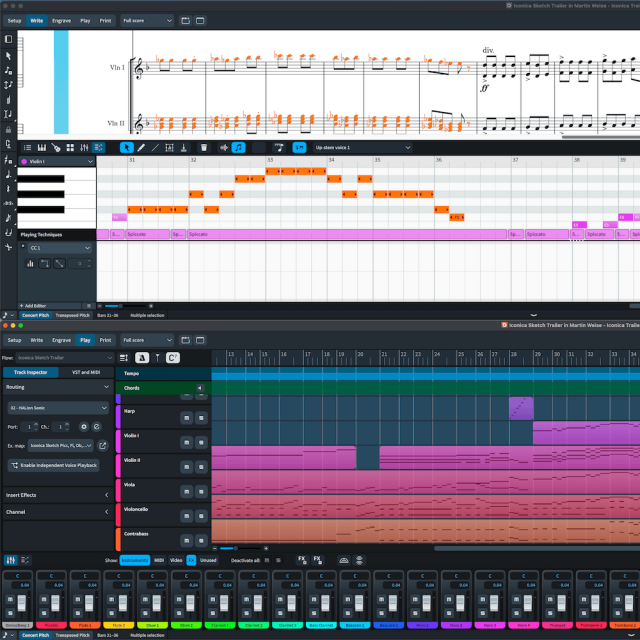Dorico 5.1 is out, and it’s a fantastic update!
But wait, I never did get around to posting about Dorico 5 when it came out in…May?
Well, to my credit, I did write about it. I was relatively satisfied with it, but there were a lot of people on the official Facebook group and the official Dorico forums who were upset by the perceived focus on playback features.
And then Daniel Spreadbury made this post1. While it’s been a minute since it was originally written, I find it just as necessary now to highlight as I did then. It’s a long read, but I highly encourage reading it in its fullness. It’s a masterclass in public relations, in transparency, and in humility – something that I find to be depressingly absent from so much modern discourse, especially online.
So if you want my initial thoughts on Dorico 5.0, I threw them up as a Github Gist2. It’s a mostly finished post.
So onto Dorico 5.1: Long story short, it delivers on the whole point of “there are great point releases coming.”
To me, the most exciting features are the ‘instrument families editor’ and the ‘score order editor.’ I haven’t had enough time to figure out if the former will allow me to make the default transposition for a euphonium to be concert pitch, but I’m hopeful once I get some time to treat it as the most important thing in my life. The latter proves to a be a good workflow improvement to anyone who wants something outside of the existing score orders on a recurring basis (the program can already handle ‘no score order’ in a single project, but if you wanted to reuse that order or add additional players on existing instruments, I could see how this improves things). The update also brings a proper jazz band score order, so to my mind that only leaves brass bands and small ensembles (like woodwind quintets) that the program doesn’t already offer out of the box. I remain grateful for the existing band score order that ships with Dorico, in the hopes that it will save people from making ill-informed decisions.
There’s a lot of other features, too! The crashing of the audio engine has long been one of the most frustrating crash states the program can hit (though it’s been rare for me) as it’s previously been unclear to many users how to get the program to start again after this occurs. Knowing to force quit the VSTAudioEngine process is no longer necessary, though, as the program can solve this itself now.
Playback improvements continue with Iconica Sketch and playback for fermatas. For the latter, it really feels like a finally. I understand that development requires prioritization, but it’s really felt like a limitation for awhile. That said, the immense and granular control continues to reinforce the idea that the “Dorico way” isn’t simply doing the thing, but doing the thing with as much customization and flexibility as one could ever desire. Their ethos continues to seem to be that “we won’t put a feature out until it’s going to be everything we feel it needs to be,” even when those features sometimes feel overdue with how mature Dorico has gotten.
The last feature work explaining anything about is the support for a subset of Markdown in project info. Entering text like “The Musical – *Chairs*” can now render “The Musical – Chairs” in the output. The subset of Markdown here is just *Italic*, **Bold**, and ***Both***. _Underscores_ substitute in for asterisks on all three formats for those who prefer them. Given the place this occupies, I don’t think any other parts of the Markdown spec really make sense, though when making worksheets that feature a lot of content in a text frame… maybe this lays the groundwork for further improvements.
Other quick notes/highlights are:
- Edit history
- Stats panel
- New text export features
- Improvements with cautionary key signatures
- Rhythmic slashes in cues
- Hidden input in popovers!
- Printing individual flows as separate files
These are all nice features, some of which satisfy long-standing entries on my personal wishlist and some I didn’t realize I really wanted. I’m greedy, so I’m already hoping for 5.2 goodies.
For more coverage on this, Scoring Notes has a good breakdown, and the official Dorico blog has a lot of video explanations.
- This is on Facebook, but it should be publicly available, even if you don’t have an account. ↩
- I actually prefer Pastebin to Github Gists in general, but for Markdown formatting, Github is hard to beat. ↩

Dorico 5.1: Filling the gaps - Scoring Notes
The Dorico 5.1 improvements run the gamut, with new features in notation, engraving, productivity, organization, and playback.Ben Byram-Wigfield (Scoring Notes)
This website uses cookies to recognize revisiting and logged in users. You accept the usage of these cookies by continue browsing this website.
Sandro Santilli
in reply to Ehler • • •Ehler
in reply to Sandro Santilli • • •Sandro Santilli
in reply to Ehler • • •Ehler
in reply to Sandro Santilli • • •Try Dorico Now for 60 Days for Free
www.steinberg.netSandro Santilli
in reply to Ehler • • •Ehler
in reply to Sandro Santilli • • •Sandro Santilli
in reply to Ehler • • •